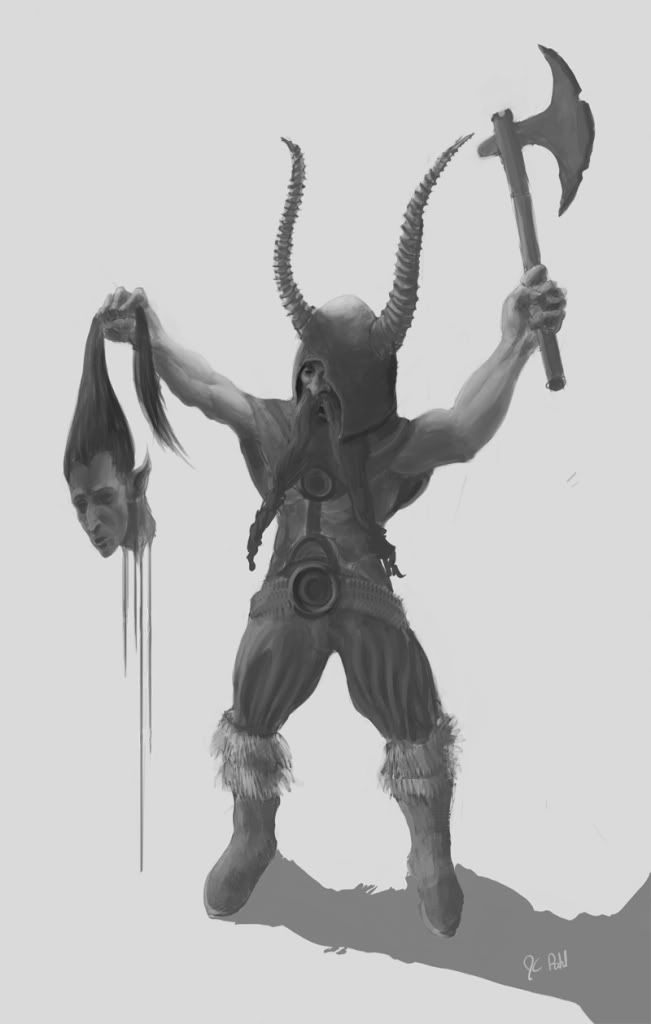
I like to start with a line-drawing when I paint, but I think this is more a personal preference than anything else. Some artists start with lines, some with masses of shadow and light, and I'm aware of much better artists than me who start with random chaos and pull from that. I think line is the easiest for noobs like me, though.
I start with a gesture, drawing the head and spinal curve first, then establishing the angles of the shoulders and hips. I also sketch in the mass of the rib cage and the pelvis. Once I have a basic skeleton set in the pose I want, I start blocking in muscle groups. I've done a lot of anatomy study, and I still spend ages on these initial steps trying to get the figure to look right. It helps if you can find reference (I didn't use any on this pic). Regardless, you can never do too many anatomy studies.
You'll notice that this figure is barely 5 heads tall (a human is 7-8 heads tall on average). This is intentional, 'cuz he's supposed to be a dwarf.
Heads and hands are the most difficult and arguably the most important. Rockwell said that 'if you get the head and the hands right, they'll forgive you anything else.' The nice thing about drawing hands is that you can always pose your own the way you want it and use it as a model. I think the key to drawing the head is knowing how to draw the skull; except for a few major masses like the masseter muscle, the head conforms very tightly to the skull.

After I have a rough line sketch, I'll block in some basic values. Right away, the most important thing to do is to establish your light source. Mine is to the upper left of the character, as you can see. I don't get too carried away in detail at this stage; mostly, I'm just establishing local value that I can model later on. Think in terms of planes at this stage; value change = plane change.

So now that I have the body of the character roughed in, I can start clothing it. I turn the opacity jitter on my brush off and set the opacity to 90% or so, so I get sort of a marker effect. Then I just start drawing shapes over the character and trying to figure out what his costume is like. I'll do this on a new layer, so that I can erase back out without ruining the underlying figure, and so I can trash the whole mess if it starts to look bad (I do this a lot). Costumes are hard; you really have to do a lot of studies of actual costumes to be able to draw them from imagination. I need to do a lot more.

After I've roughed in a costume over the figure, I'll start rendering. I set my brush opacity to 95% or so and set opacity and size jitter to pen pressure. I think the trick to rendering is to imagine the object you're painting is actually 3-dimensional, instead of a 2D painting... if that makes sense. And keep the light source in mind, of course.

More rendering. I use the airbrush to tighten everything up, and I used to textured brushes to add interest.
Some general tips:
*it's a good idea to work zoomed-out most of the time; this keeps you from getting preoccupied with details and helps you keep all parts of the piece relating to and working with each other.
*use the largest size brush you can. Sargent actually advised to select the biggest brush possible, and then use a brush even a size bigger than that. This maintains good stroke economy - keeps the painting from getting scratchy.
*think of shadow as a liquid. Pay attention to shadow-edges: as a general rule, form shadows have soft edges, cast shadows have hard edges.
Hope that's helpful.


 Author
Topic: Art Request (Read 1208 times)
Author
Topic: Art Request (Read 1208 times)

